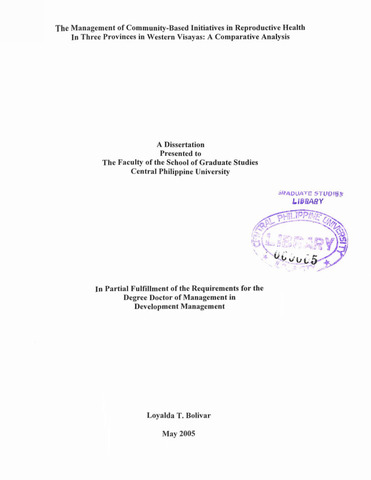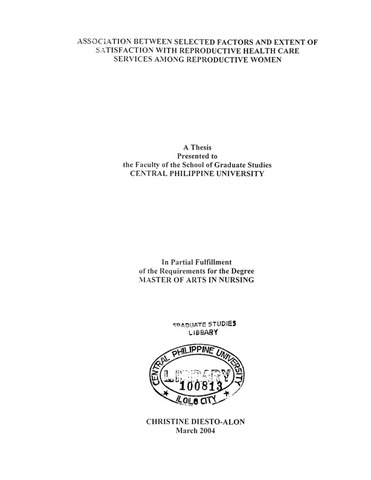| dc.description.abstract | This study was pursued to determine the relationship of socio-demographic, environmental factors associated with health condition and health seeking behavior among labor age group in selected urban communities in Iloilo City. Specifically, this study sought to determine the socio-demographic characteristics of the residents in terms of age, civil status, educational attainment, work status and monthly family income; the environmental characteristics of the residents in terms of crowding index, type of toilet, garbage disposal and presence of environmental pollutants; the health seeking behavior of the residents as to whether it they utilized or did not utilize available health care services; the health status of the residents; if there is a significant relationship between socio-demographic characteristics of the residents and their health status; if there is a significant relationship between the environmental characteristics of the residents and their health status; and if there is a significant relationship between the health seeking behavior of the residents and health status.
This study utilized secondary data. It made use of the data gathered by David (2015) of the Social Science Research Institute (SSRI) and the Panay Power Corporation (PPC) in 2015. The original study sampled 2070 households in 19 barangays surrounding the Coal-fired Power Plant in the District of La Paz and Jaro, Iloilo with a total population of 9,355. Variables used in this study were the sociodemographic characteristics of the respondents in terms of age, sex, civil status, educational attainment, work status and monthly family income and the environmental factors in terms of crowding index, type of toilet, garbage disposal and presence of environmental pollutants. From the data generated from the study, the researcher determined the five top most barangays with the highest morbidity. These barangays were the only barangays included in the study. The study also covered respondents who are of labor force age and are in their most productive years of 15 - 64 years old. Respondents covered the top 5 barangays with the highest incidence of sickness which are Balabago, Tabuc Suba, Baldoza, Cubay and Jereos.
Descriptive analysis using frequency distribution, percentage, measures of central tendency and inferential analysis employing the Chi-square test, Cramer’s V and Gamma test statistics.
Based on the finding, The average age of males were 34.16 with almost three out of ten (29.23%) of them were 15 to 24 years old. There were almost the same proportion of males (49.51%) and females (50.49%), and half of the respondents were married (52.67%). In addition, most of ten respondents were high school or vocational educated (63.78%) and only little more than a half were gainfully employed (56.97%) but belonged to the lowest income bracket of 5,000 and below (59.05%).
More than one third (44.19%) of the labor force age group were living houses with a crowding index of 3 to 4 and with the average crowding index of 3.37. Almost all of the respondents have sanitary toilets (97.65%), disposed garbage through the city’s garbage collection service (75.03%), and were not bothered or exposed to environmental pollutants (92.88%).
Although more than half (79.83%) of the labor force age group never got sick, little more than a fifth (20.17%) of them got sick in the last 12 month. Moreover, a little more than half (52.53%) of those who got sick sought for treatment while 47.47 % did not. Among those who sought for treatment, a little more than half (56.59%) consulted at the RHU or health center.
Those who got sick manifested more than one symptom. The most common symptoms were combination of fever, cough and runny nose, cough alone, fever and cough, cough and runny nose, and headache.
Relational analysis revealed that age, civil status, educational attainment and income are significantly associated with health condition of labor force age group, however, sex, and work status and income were found to have no significant bearing on labor force age groups health condition.
The result of this study further showed that crowding index, type of toilet, garbage disposal and presence of environmental pollutants were not related to health condition of labor force age group.
This study also revealed that age, civil status, educational attainment and income had a significant relationship with health seeking behavior. Nonetheless, sex, and work status and income had nothing to do with it.
The relational analysis further showed that health seeking behavior was directly related to health status with many of those who are sick availing of the servicers of the Rural Health Unit. This supports the Behavioral Model of Health Care Utilization wherein among the individual determinants of availing of health care services is the need factors, wherein the strongest determinants of immediate health service use is presented as functional and health problems that generate the need for health care services such as health condition and illness level. Thus the findings of this study shows that the behavior of an individual to seek treatment is determined by their health condition.
Based on the major findings of this study, the following conclusions were drawn:
The residents in the barangays with the highest morbidity are mostly in the labor force age group with many of them in the youngest age group and have reached secondary education. With an average income of below the poverty threshold, these residents could be considered poor and marginalized with limited economic means to meet the basic necessities in life.
The residents in the barangays with highest morbidity live in dwelling places that have adequate space and are not overcrowded, have sanitary toilets, practice proper garbage disposal and are not exposed to environmental pollutants. However, there are still many who find themselves in overcrowded homes, have unsanitary or no toilet at all, while practicing improper disposal of garbage and live in areas that are putting not only themselves at greater risk of getting sick but their household and community, as well.
The residents who did not get sick did not seek medical health and not all who got sick utilized health care services.
Among the socio-demographic variables, it was age, civil status, educational attainment and income which was found to have a significant correlation with health condition whereby the older one gets, there is a possibility that the poorer the health status would be. Moreover, widows, those with lower educational attainment and income have poorer health condition. The first hypothesis is therefore not accepted only in terms of age, civil status, educational attainment and income but accepted in terms of sex and work status.
Crowding index, type of toilet, garbage disposal and presence of pollutants did not have a bearing on the health status of the residents. The second hypothesis is therefore accepted.
Among the socio-demographic variables, it was age, civil status, educational attainment and income which was found to have a significant relationship with health seeking behavior whereby the older one gets, widows, higher education and income sought medical help more when they are sick. The fourth hypothesis is therefore not accepted only in terms of age, civil status, educational attainment and income but accepted in terms of sex and work status.
Health seeking behavior was related to health condition whereby those who did not get sick did not utilize health care services available. The fifth hypothesis is therefore not accepted. | en_US |





